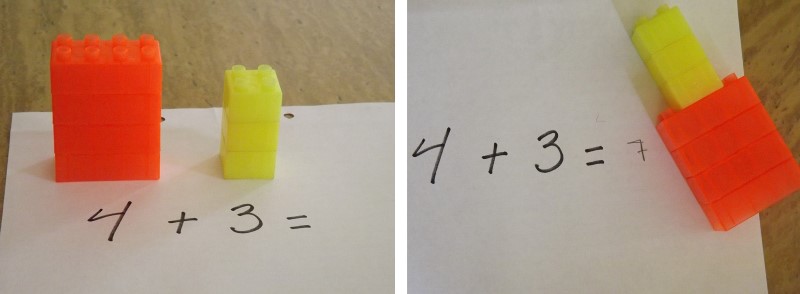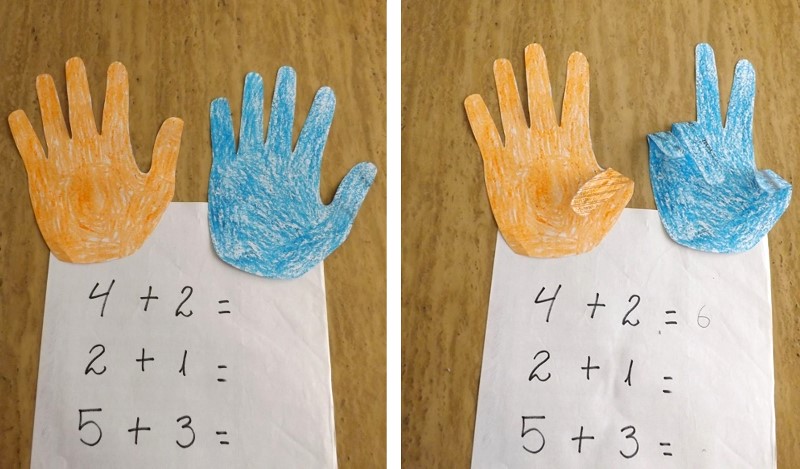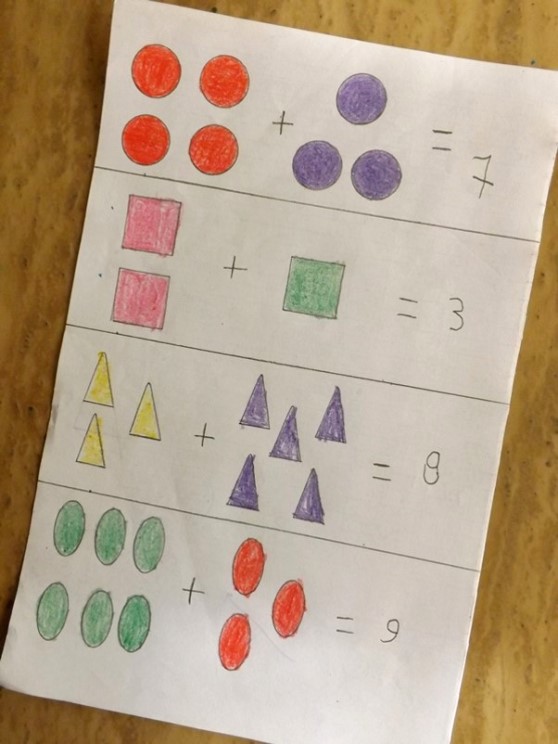Las matemáticas pueden ser una gran herramienta para aprender jugando con los niños.
Hello Home Edder friends.
Mathematics can be a great tool to learn by playing with children.

Y una vez que ya conocen los números y la cantidad que representan es hora de iniciarlos en las operaciones matemáticas, siendo lo primero aprender a sumar, pero este es un proceso gradual ya que no aprenden todo al mismo tiempo, iniciamos sumando números de un solo digito para ir introduciendo el concepto; y que mejor manera de iniciar el aprendizaje de las matemáticas sino con juegos.
And once they already know the numbers and the amount they represent it is time to start them in mathematical operations, the first thing to learn is to add, but this is a gradual process because they do not learn everything at the same time, we start adding single digit numbers to introduce the concept; and what better way to start learning mathematics but with games.
Seguramente podemos encontrar muchas estrategias y juegos que se pueden adaptar a los gustos de cada niño y con ello hacer que de forma divertida vayan interiorizando este concepto que necesitaran en su día a día. Estos son algunos juegos que pueden ayudarte a iniciar con los niños el concepto de sumar.
Surely we can find many strategies and games that can be adapted to the tastes of each child and thus make a fun way to internalize this concept that they will need in their day to day. These are some games that can help you to start with children the concept of addition.
Sumar bolitas de papel / adding paper balls
Un par de vasos de plástico y unas bolitas de papel pueden convertirse en toda una atracción para aprender a sumar, solo necesitamos adicionalmente dos dados. El niño debe lanzar los dados para obtener las cifras que deberá sumar, luego colocará en un vaso la cantidad de bolitas de papel que correspondan al número que ha salido en un dado, haciendo lo mismo con el otro vaso, para conocer el resultado de la suma solo deberá unir la cantidad de bolitas de papel en otro recipiente y contar el total.
A couple of plastic cups and some paper balls can become an attraction to learn how to add, we only need two additional dice. The child must throw the dice to get the numbers to be added, then place in a glass the amount of paper balls that correspond to the number that came out on the dice, doing the same with the other glass, to know the result of the sum you only have to join the amount of paper balls in another container and count the total.

Sumas con piezas de construcción / Sums with building blocks
Me encantan los cubos de armar, estas piezas de construcción sirven para jugar y aprender de muchas formas con ellos. Para enseñar el concepto de sumar solo necesitamos de una hoja de papel y de algunos cubos de construcción, sobre la hoja coloca la operación que le propondrás a tu niño, representándola por dos torres de cubos con las cantidades que debe sumar, el deberá unir los cubos en una sola torre alta que representara el resultado y colocar la cantidad en la hoja.
I love building blocks, these construction pieces are useful to play and learn in many ways with them. To teach the concept of addition we only need a sheet of paper and some construction cubes, on the sheet place the operation that you will propose to your child, representing it by two towers of cubes with the amounts to be added, he must join the cubes in a single high tower that will represent the result and place the amount on the sheet.

Sumar con los dedos / Adding with your fingers
Creo que a todos nos deben haber enseñado a sumar con los dedos, y es algo que los niños comprenden rápidamente, mi hijo se ayuda mucho contando con sus dedos. Esta es una forma un poco más creativa y divertida de hacerlo; solo necesitamos dibujar un par de manos de cartulina o fieltro y pegamos sobre una hoja donde colocaremos varias operaciones, para encontrar el resultado el niño solo debe levantar o bajar los dedos que sean necesarios para coincidir con las cantidades a sumar y contar el total de dedos. Es el mismo principio que usar los dedos de las manos, pero así le quedan sus manos libres para contar y escribir.
I think we all must have been taught to add with our fingers, and it is something that children understand quickly, my son helps himself a lot by counting with his fingers. This is a slightly more creative and fun way to do it; we just need to draw a pair of cardboard or felt hands and stick them on a sheet where we will place several operations, to find the result the child just has to raise or lower the fingers that are necessary to match the amounts to be added and count the total of fingers. It is the same principle as using the fingers of the hands, but this leaves the child's hands free to count and write.

Fichas para sumar / Addition flashcards
Las fichas son ideales para iniciar a los niños en las sumas, ya que son una herramienta muy sencilla y visual. Se pueden hacer muy fácilmente o también se pueden encontrar gran variedad en internet para imprimir. Nosotros elegimos hacerlas, solo basta con hacer dibujos de objetos o animalitos para representar las cantidades que se van a sumar, así nuestro niño puede contarlos fácilmente para encontrar el resultado.
Flashcards are ideal for introducing children to addition, as they are a very simple and visual tool. They can be easily made or you can find a great variety on the internet to print them. We choose to make them, just draw pictures of objects or animals to represent the quantities to be added, so our child can easily count them to find the result.

Bueno amigos espero les hayan gustado estas cuatro estrategias, formas divertidas de aprender basadas en el juego y en la manipulación de materiales, ya que la manera más fácil de aprender a sumar es mediante la relación de esta operación con objetos reales con los cuales los niños tengan contacto, no solo son números que deben memorizar, por eso debemos hacerlas divertidas con actividades lúdicas, así quizás evitemos ese odio matemático que muchos niños sienten cuando ven las operaciones de cálculo. Recuerden ir paso a paso, tomando pocos objetos al principio, cada niño aprende a su ritmo y encuentra su propia manera de asimilar los conceptos.
Well friends I hope you liked these four strategies, fun ways to learn based on play and manipulation of materials, because the easiest way to learn to add is through the relationship of this operation with real objects with which children have contact, they are not only numbers to memorize, so we must make them fun with playful activities, so maybe we avoid that mathematical hatred that many children feel when they see the calculation operations. Remember to go step by step, taking few objects at the beginning, each child learns at his own pace and finds his own way to assimilate the concepts.
Gracias por pasar a leer, hasta la próxima! / Thanks for reading, see you next time!
I love how creative and really fun ideas are varied and children will not get tired, because initially the problem with mathematics is that there is a certain degree of rejection to think that they are complicated and boring and in your post you show that it is not so and that everything depends on the way we approach their learning. Excellent thanks for sharing.
Hi @majo77, I think that sometimes we are the ones who transmit them that idea if we show them that they are boring for us, that's why it is important to make their learning fun, so as not to introduce that well-known rejection to mathematics. Thanks to you for reading!
These are fun activities to develop one's numeracy skills. As part of the growth learning of the child with a great foundation of training and practices, it will result in a positive one. Nice one and can't wait to know more activities that I can share with my students as well.
Hi @missdonna. Certainly the motivation of children depends on making the activities fun, I hope you find these ideas and the next ones useful.
Some really fun ways to introduce addition to children. Tracing hands and folding the fingers up and down is pretty cute. -Aimee
Hola amiga. Thank you very much, you have to look for resources that are fun and the truth is that many of them are easy to do.
That paper hand is certainly a genius way of teaching a child to learn counting and addition. Great job.
Thank you my friend! It is one of the most entertaining and didactic resources, because they find it very easy to count with their fingers.
You're welcome.
A good example of how many different fun approaches to maths you can use. I really like the hands and fingers. Do you add feet and toes when they move past 10? 😉
I used Lego bricks to explain decimals to my youngest when she was struggling, so they are something that can extend quite far into maths learning.
Thanks friends, I think that by putting some interest we will find many fun ways to teach math. It's not a bad idea to add the toes to count to 20 hehe, I'll do a post later with some ideas for two digit numbers. And yes, Lego bricks can be very versatile for learning. Thanks for your support!
Gracias!
Beautiful and fun strategies that you show @emiliomoron really is a very enjoyable way to achieve meaningful learning of mathematics because in most cases it is complicated both explain them and learn them, I think that particular I still have deficiencies associated with the schemes that were used for me to learn them, the way in which you show the natural process of learning mathematics is very significant certainly you should not run over any process and the development of mathematical logical thinking is one of the most complex but in that way in which you point out step by step our children can get not only learn but love mathematics. Excellent post
That's right @emimoron, the important thing is to make it simple and fun for children, because they are fundamentals that may be abstract at first and we do not want them to hate mathematics, but to see its usefulness. Thanks for stopping by to read, greetings!
I've featured your post in the @HomeEdders weekly curation.
Curated by @minismallholding on behalf of @HomeEdders.
Supporting home education and educational content. If you're a home educator, home educated or are thinking about home education, find out what we're about HERE.
You can join the community by clicking the subscribe button on Hive or Peakd.
please feel free to join us on discord.
Hello friends of @HomeEdders, thank you very much for your support!